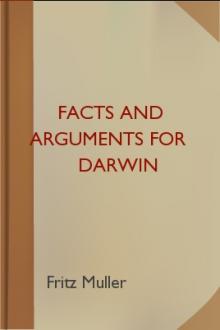The Expression of Emotion in Man and Animals by Charles Darwin (adult books to read TXT) 📕

- Author: Charles Darwin
- Performer: -
Book online «The Expression of Emotion in Man and Animals by Charles Darwin (adult books to read TXT) 📕». Author Charles Darwin
[29] See the account by Dr. R. Brown, in Proc. Zool. Soc. 1871, p. 39.
He says that as soon as a pig sees a snake it rushes upon it; and a snake makes off immediately on the appearance of a pig.
[30] Dr. Gunther remarks (`Reptiles of British India,’ p. 340) on the destruction of cobras by the ichneumon or herpestes, and whilst the cobras are young by the jungle-fowl. It is well known that the peacock also eagerly kills snakes.
[31] Prof. Cope enumerates a number of kinds in his `Method of Creation of Organic Types,’ read before the American Phil. Soc., December 15th, 1871, p. 20. Prof. Cope takes the same view as I do of the use of the gestures and sounds made by snakes. I briefly alluded to this subject in the last edition of my `Origin of Species.’ Since the passages in the text above have been printed, I have been pleased to find that Mr. Henderson (`The American Naturalist,’ May, 1872, p. 260) also takes a similar view of the use of the rattle, namely “in preventing an attack from being made.”
The Drawing back and pressure of the Ears to the Head.—The ears through their movements are highly expressive in many animals; but in some, such as man, the higher apes, and many ruminants, they fail in this respect. A slight difference in position serves to express in the plainest manner a different state of mind, as we may daily see in the dog; but we are here concerned only with the ears being drawn closely backwards and pressed to the head.
A savage frame of mind is thus shown, but only in the case of those animals which fight with their teeth; and the care which they take to prevent their ears being seized by their antagonists, accounts for this position. Consequently, through habit and association, whenever they feel slightly savage, or pretend in their play to be savage, their ears are drawn back.
That this is the true explanation may be inferred from the relation which exists in very many animals between their manner of fighting and the retraction of their ears.
[32] Mr. des Voeux, in Proc. Zool. Soc. 1871, p. 3.
All the Carnivora fight with their canine teeth, and all, as far as I have observed, draw their ears back when feeling savage.
This may be continually seen with dogs when fighting in earnest, and with puppies fighting in play. The movement is different from the falling down and slight drawing back of the ears, when a dog feels pleased and is caressed by his master.
The retraction of the ears may likewise be seen in kittens fighting together in their play, and in full-grown cats when really savage, as before illustrated in fig. 9 (p. 58). Although their ears are thus to a large extent protected, yet they often get much torn in old male cats during their mutual battles.
The same movement is very striking in tigers, leopards, &c., whilst growling over their food in menageries.
The lynx has remarkably long ears; and their retraction, when one of these animals is approached in its cage, is very conspicuous, and is eminently expressive of its savage disposition.
Even one of the Eared Seals, the Otariapusilla, which has very small ears, draws them backwards, when it makes a savage rush at the legs of its keeper.
When horses fight together they use their incisors for biting, and their fore-legs for striking, much more than they do their hind-legs for kicking backwards. This has been observed when stallions have broken loose and have fought together, and may likewise be inferred from the kind of wounds which they inflict on each other. Every one recognizes the vicious appearance which the drawing back of the ears gives to a horse.
This movement is very different from that of listening to a sound behind.
If an ill-tempered horse in a stall is inclined to kick backwards, his ears are retracted from habit, though he has no intention or power to bite.
But when a horse throws up both hind-legs in play, as when entering an open field, or when just touched by the whip, he does not generally depress his ears, for he does not then feel vicious. Guanacoes fight savagely with their teeth; and they must do so frequently, for I found the hides of several which I shot in Patagonia deeply scored. So do camels; and both these animals, when savage, draw their ears closely backwards.
Guanacoes, as I have noticed, when not intending to bite, but merely to spit their offensive saliva from a distance at an intruder, retract their ears.
Even the hippopotamus, when threatening with its widely-open enormous mouth a comrade, draws back its small ears, just like a horse.
Now what a contrast is presented between the foregoing animals and cattle, sheep, or goats, which never use their teeth in fighting, and never draw back their ears when enraged! Although sheep and goats appear such placid animals, the males often join in furious contests.
As deer form a closely related family, and as I did not know that they ever fought with their teeth, I was much surprised at the account given by Major Ross King of the Moose-deer in Canada. He says, when “two males chance to meet, laying back their ears and gnashing their teeth together, they rush at each other with appalling fury.”[33] But Mr. Bartlett informs me that some species of deer fight savagely with their teeth, so that the drawing back of the ears by the moose accords with our rule.
Several kinds of kangaroos, kept in the Zoological Gardens, fight by scratching with their forefeet and by kicking with their hind-legs; but they never bite each other, and the keepers have never seen them draw back their ears when angered. Rabbits fight chiefly by kicking and scratching, but they likewise bite each other; and I have known one to bite off half the tail of its antagonist.
At the commencement of their battles they lay back their ears, but afterwards, as they bound over and kick each other, they keep their ears erect, or move them much about.
[33] `The Sportsman and Naturalist in Canada,’ 1866, p. 53. p. 53.{sic}
Mr. Bartlett watched a wild boar quarrelling rather savagely with his sow; and both had their mouths open and their ears drawn backwards.
But this does not appear to be a common action with domestic pigs when quarrelling. Boars fight together by striking upwards with their tusks; and Mr. Bartlett doubts whether they then draw back their ears.
Elephants, which in like manner fight with their tusks, do not retract their ears, but, on the contrary, erect them when rushing at each other or at an enemy.
The rhinoceroses in the Zoological Gardens fight with their nasal horns, and have never been seen to attempt biting each other except in play; and the keepers are convinced that they do not draw back their ears, like horses and dogs, when feeling savage. The following statement, therefore, by Sir S. Baker[34] is inexplicable, namely, that a rhinoceros, which he shot in North Africa, “had no ears; they had been bitten off close to the head by another of the same species while fighting; and this mutilation is by no means uncommon.”
Lastly, with respect to monkeys. Some kinds, which have moveable ears, and which fight with their teeth—for instance the Cereopithecus ruber—
draw back their ears when irritated just like dogs; and they then have a very spiteful appearance. Other kinds, as the Inuus ecaudatus, apparently do not thus act. Again, other kinds—and this is a great anomaly in comparison with most other animals—retract their ears, show their teeth, and jabber, when they are pleased by being caressed. I observed this in two or three species of Macacus, and in the Cynopithecus niger.
This expression, owing to our familiarity with dogs, would never be recognized as one of joy or pleasure by those unacquainted with monkeys.
[34] `The Nile Tributaries of Abyssinia,’ 1867, p. 443.
Erection of the Ears.—This movement requires hardly any notice.
All animals which have the power of freely moving their ears, when they are startled, or when they closely observe any object, direct their ears to the point towards which they are looking, in order to hear any sound from this quarter. At the same time they generally raise their heads, as all their organs of sense are there situated, and some of the smaller animals rise on their hind-legs. Even those kinds which squat on the ground or instantly flee away to avoid danger, generally act momentarily in this manner, in order to ascertain the source and nature of the danger.
The head being raised, with erected ears and eyes directed forwards, gives an unmistakable expression of close attention to any animal.
CHAPTER V.
SPECIAL EXPRESSIONS OF ANIMALS.
The Dog, various expressive movements of—Cats—Horses—Ruminants—Monkeys, their expression of joy and affection—Of pain—Anger—Astonishment and Terror.
The Dog.—I have already described (figs. 5 and 1) the appearance of a dog approaching another dog with hostile intentions, namely, with erected ears, eyes intently directed forwards, hair on the neck and back bristling, gait remarkably stiff, with the tail upright and rigid. So familiar is this appearance to us, that an angry man is sometimes said “to have his back up.”
Of the above points, the stiff gait and upright tail alone require further discussion. Sir C. Bell remarks[1] that, when a tiger or wolf is struck by its keeper and is suddenly roused to ferocity, every muscle is in tension, and the limbs are in an attitude of strained exertion, prepared to spring.
This tension of the muscles and consequent stiff gait may be accounted for on the principle of associated habit, for anger has continually led to fierce struggles, and consequently to all the muscles of the body having been violently exerted.
There is also reason to suspect that the muscular system requires some short preparation, or some degree of innervation, before being brought into strong action.
My own sensations lead me to this inference; but I cannot discover that it is a conclusion admitted by physiologists.
Sir J. Paget, however, informs me that when muscles are suddenly contracted with the greatest force, without any preparation, they are liable to be ruptured, as when a man slips unexpectedly; but that this rarely occurs when an action, however violent, is deliberately performed.
[1] `The Anatomy of Expression,’ 1844, p. 190.
With respect to the upright position of the tail, it seems to depend (but whether this is really the case I know not) on the elevator muscles being more powerful than the depressors, so that when all the muscles of the hinder part of the body are in a state of tension, the tail is raised.
A dog in cheerful spirits, and trotting before his master with high, elastic steps, generally carries his tail aloft, though it is not held nearly so stiffly as when he is angered. A horse when first turned out into an open field, may be seen to trot with long elastic strides, the head and tail being held high aloft. Even cows when they frisk about from pleasure, throw up their tails in a ridiculous fashion.
So it is with various animals in the Zoological Gardens. The position of the tail, however, in certain cases, is determined by special circumstances; thus as soon as a horse breaks into a gallop, at full speed, he always lowers his tail, so that as little resistance as possible may be offered to the air.
When a dog is on





Comments (0)